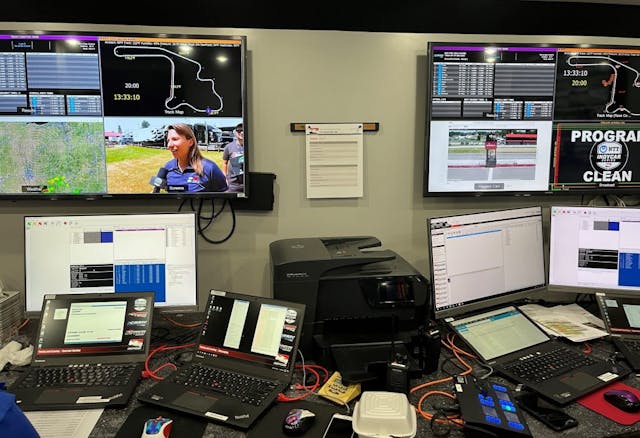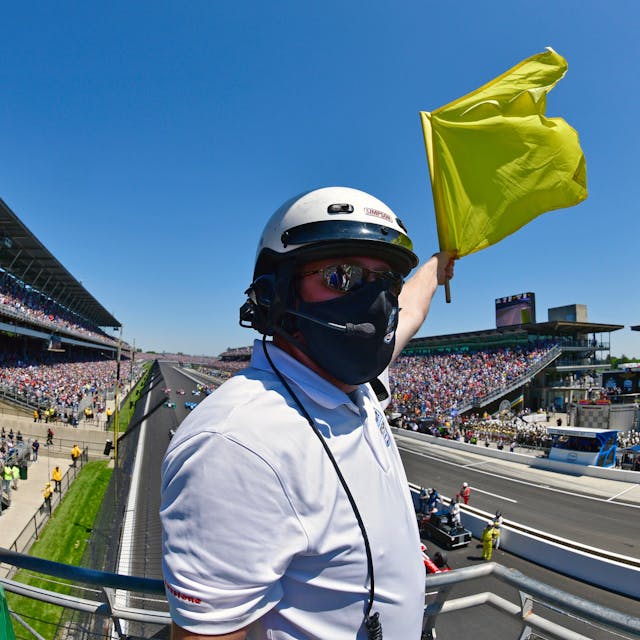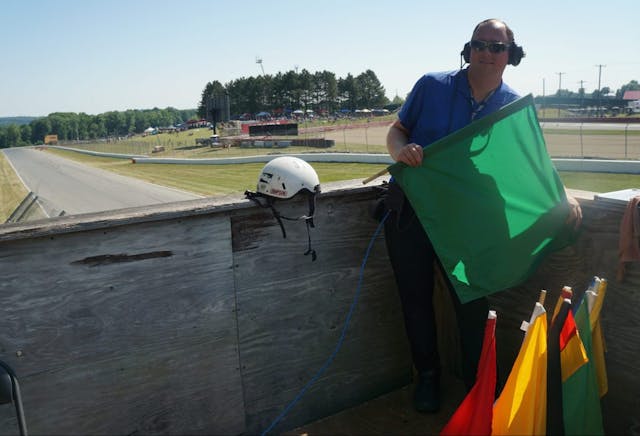Media | Articles
IndyCar’s head flagman follows his dreams while raising autism awareness
Standing with Aaron Likens on top of Mid-Ohio’s flag stand I couldn’t help but to be influenced by his infectious passion. The green flag snapping in the sky, above the field of Indy race cars, was hypnotizing. He made the flag dance. Likens says that he tries to capture the excitement of the moment in the way he waves the flags. This was clearly a man at the top of his game doing what he loved.
At four years old, Aaron was already training to be a flagman. Really. Watching NASCAR races in his living room, Aaron would stand in front of the TV and flag the entire race. Once his father saw how much of a motorsports fan his child was becoming, he purchased a set of flags from the Indianapolis Motor Speedway gift shop.
Aaron’s interest in flagging grew even larger when he attended the Indy 500 and saw his new hero Duane Sweeney, the former starter and flagman for the Indianapolis 500 from 1980 to 1996. Likens was captivated with the speed, color, and competition, but he was most fascinated by the man in the flag stand. Instead of Rahal or Andretti, chief starter Sweeney became his childhood hero.

Likens didn’t know it at the time—and unfortunately wouldn’t be diagnosed until he was 20 years old—but he was on the autism spectrum. Many such people have difficulty processing everyday sensory information. They can be either over-reactive or under-reactive to sensory input. For Aaron, there was just something about seeing and even hearing the colored flags waving in the air that fascinated him, perhaps because of his heightened processing.
One year, Likens’ father contacted Sweeney for an autographed picture. When word reached the IndyCar starter that a pastor’s kid wanted an autograph, he had his wife do something special for his young fan. Before every Indianapolis 500, Mary Sweeney bought material and cut 35 squares to hand make two black-and-white flags. One for the winner, and one to the museum. That year she made a third flag that Duane signed and gave to seven-year-old Aaron.
Marketplace
Buy and sell classics with confidence
That small act of kindness from the late flagman meant a lot and helped solidify Aaron’s dreams as a child. He either wanted to race in the Indy 500 … or be its flagman. By third grade, he was spending hours each day standing on a rock in his front yard waving that checkered flag to passing cars.

By sixth grade, he was racing karts. The only struggle he had with karting was that his dad wanted him to help work on the vehicle. Getting his hands all dirty was not a feeling he enjoyed. The flagman at their local track was an 85-year-old gentleman that Likens admired. His father made him a deal: When Aaron wasn’t racing, he could either work on the kart or help the flagman.
You can probably guess what he chose. And it was a good thing he did, as that gentleman unfortunately was starting to lose his color vision. What began with Aaron handing him the correct flags transitioned to Aaron actually being the flagman once the older gentleman retired. By 13, Likens was the head flagman for the St. Louis Karting Association, which made him one of the youngest chief starters in American racing.

Working at his local karting track was great, but it didn’t minimize the difficulties he had with anxiety and social interactions. Communicating with others was a challenge, and friends were tough to come by. When Likens was 20 years old, he was officially diagnosed with Asperger’s syndrome, a neurodevelopment disorder characterized by significant difficulties in social interaction and non-verbal communication. Unfortunately, in 2003, there wasn’t information available to understand what that meant, not even from his doctor. An initial internet search crushed him when he read an article stating people with Asperger’s “would never have a job, never have friends, and never be happy.” With nothing telling him otherwise, he believed it.

For the next 14 months he fell into a deep state of depression. “I allowed that diagnosis to define me,” he said. “That internet article almost ruined me.” When he had trouble explaining how he felt, he turned to writing.
What started as a journal to his parents to help them understand who he was eventually turned into book about thoughts and explanations for people on the autism spectrum called Finding Kansas.
The flag stand helped him in this dark time. “Knowing I still had races to work that year helped me get through,” he says. Aaron describes himself as an introvert who struggles with anxiety, but when those flags are in his hands, he’s a different person. He is confident and able to communicate with people without actually having to talk to them.
Being a flagman helped give his life purpose; it was a place he felt safe and gave him comfort. And he kept getting better at his job. He began to realize that many of his challenges were actually benefits when it came to flagging. Far from preventing his success, being on the autism spectrum was helping him excel at his role.
“Loud noises bother me away from the track, but here, my heightened sense of hearing can even help,” says Aaron. He believes for people on the spectrum that finding the right environment is key. “Over-processing everything in the classroom was tough, but at the track it helps that I can hear if a motor is slightly out of tune.” Aaron says he also has a heightened sense of smell, which came in handy at a quarter-midget race he recently flagged. He black-flagged a car because he smelled something coming from it, something that no one else at the track noticed. That is, until the car pulled into the pits and they saw gas leaking from it.
“If you start thinking, ‘why am I like this?’ then you are forgetting who you are and your strengths,” says Likens. He points out that not all cases of autism are the same, and that it takes time to understand how to help each individual person.
He also shared that, sadly, the unemployment rate for people with Asperger’s hovers around 80 to 85 percent, but it doesn’t have to be that way. “For people on the spectrum, don’t give up—there’s so much potential out there. And for people that are around us, that little bit of understanding can go a long way.”
Over the years, he worked his way up to bigger races and venues. He started flagging for the United States Auto Club (USAC) and added over 20 events a year. According to his dad, Aaron was “reliable, passionate, and dedicated to his craft.” Tom Kutcher, CEO of Superkarts! USA, the premier professional karting organization in America, heard about the flagman at the St. Louis Karting Association and made the trip to see him in person. Kutcher said, “That’s the best flagman I’ve ever seen!” Aaron has been the head flagman for the SKUSA SuperNats and their pro tour ever since.
In 2020, he got the call he had dreamed about since he was four years old. IndyCar’s senior director of technology Jon Koskey wanted Aaron to be the head flagman for IndyCar. Koskey said Aaron’s quick thinking and his talent for mentally keeping track of cars throughout a race helped him land that dream job.
“A lot of people need a data system behind them to know who’s in first or who’s a lap down … but Aaron spins it in his head. I picked Aaron because of his attention to detail is off the charts. He always knows where all the cars are, always knows the order in his head. It’s remarkable. Especially on short ovals his skills are a real value to us. He processes things so quickly, it’s like a sixth sense for him. He has less distractions than others.”

Aaron Likens’ flagging style is unique, to say the least. He brings a certain flair to the stand that has a lot of fans talking. “Oh yeah, he has made the flagger part of the show!” Koskey says.
In the past 60 years, only five people have served as the chief starter at the Indy 500. In 2021, the opportunity of a lifetime came as Aaron waved the dual checkered flags over Helio Castroneves at the Indianapolis 500. Decades after he was captivated by the man in the flag stand at the Indy 500, he became that man.
Likens continues to write about his life on his blog www.aaronlikens.com. He is also a national autism advocate, an award-winning public speaker, an instructor for police departments across the United States to better understand and work with individuals with autism, and even recently consulted with the staff of the cartoon Thomas and Friends to help develop an autistic character, Bruno the brake car:
“I had years of horrible lows, but now I’m living my dream. I want to inspire others that life with autism can lead to once in a lifetime opportunities. And I have friends and am happy, so don’t believe everything you read.”





Check out the Hagerty Media homepage so you don’t miss a single story, or better yet, bookmark us.
















